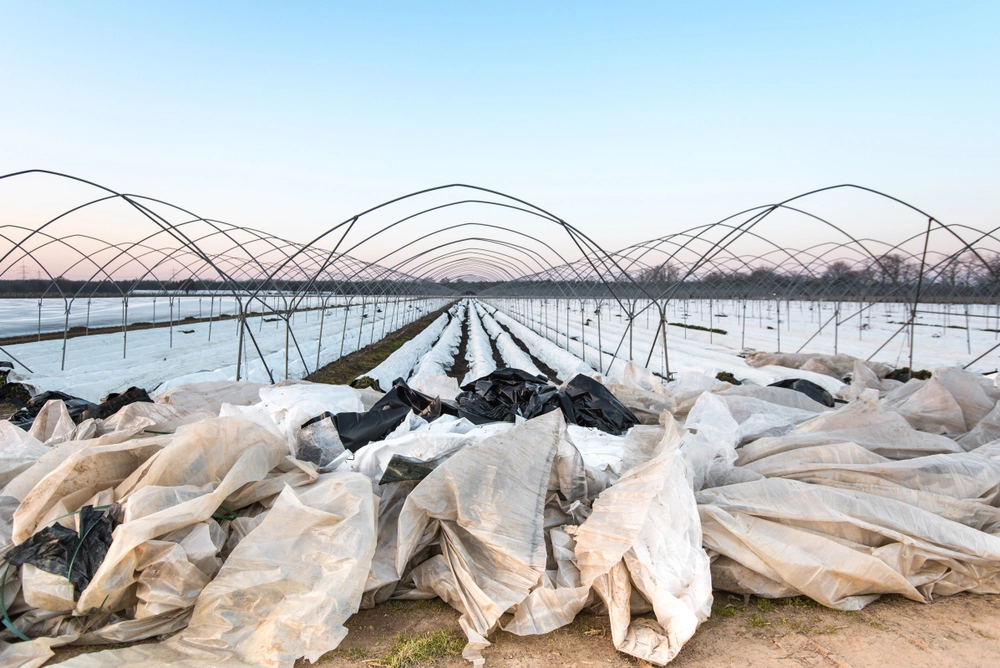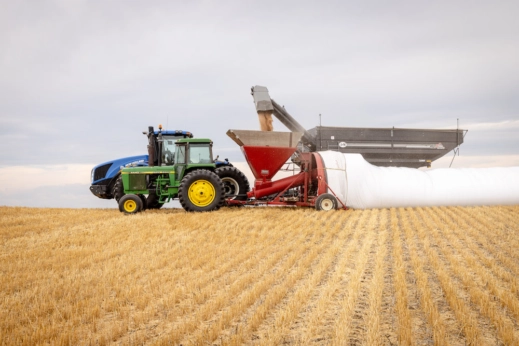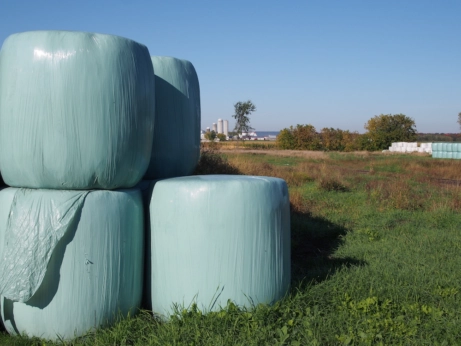Across North America, recycling companies, legislators and growers are seeking solutions to eliminate plastic waste from accumulating in farmers’ fields and in landfills.

Barry Friesen remembers the days when plastic wasn’t used on farms. “One of my first summer jobs was working as a farm hand on a dairy farm,” he recalls. “It would take a team of workers six weeks to bale hay. Now, with technology and various types of plastic tools, one person can do that job in perhaps as few as three days by themselves.”
Plastic may have made farm life easier, but it’s also caused the United Nations Food and Agricultural Organization (FAO) to raise alarm bells about its impact on the environment. Globally, 12.5 million tons of agricultural plastic is used annually. Everything from silage wraps, tote drums, containers, plastic mulch, greenhouse sheeting and row covers have a use in modern-day agriculture, although much of it is single-use and not recyclable.
The Rodale Institute, proponents of regenerative organic farming, estimate that, for every acre of land farmed using plastic mulch, between 100 and 120 pounds of plastic ends up in the landfill or breaks down into a farmer’s field. As the plastic decomposes, a process that takes up to 1,000 years to complete, it releases greenhouse gases into the atmosphere or breaks down into tiny microplastics that attach themselves to root vegetables and enter the food system.
In 2021, the FAO called for a more sustainable use of agricultural plastics and promoted a net zero plastic waste for agriculture. That’s where companies such as Cleanfarms, where Friesen is the executive director, come in.
Cleanfarms is a Canadian stewardship organization that recycles agricultural plastic. It works with manufacturers and producers of agricultural plastic to recycle products on its behalf. Partnering with local collection services and municipalities, Cleanfarms is the only stewardship organization in Canada working to clean up agricultural plastic.

Baling hay using plastic sheeting. (Photo courtesy of Cleanfarms)
In 2022, Cleanfarms reported collecting and recycling 5,000 tons of crop input and agricultural film plastic, 5.2 million empty pesticide and fertilizer containers and nearly 300,000 empty seed and pesticide bags. But despite these figures, Friesen admits that Cleanfarms is only collecting 10 percent of the agricultural plastic used on Canadian farms.
The story is not much different in the United States, where 816 million pounds of agricultural plastic is used annually. The Agricultural Container Research Council operates in 46 states collecting and recycling agricultural crop protection, animal health, fertilizer and pest control containers such as jugs and drums. Since its conception in 1992, more than 240 million tons of agricultural plastic container waste has been recycled. There are other recycling programs throughout the US, but what they collect varies from state to state.
David McDaniel is co-founder of Maine’s Greenhouse Plastic Recycling Program. He used to encourage farmers to recycle their plastic greenhouse sheeting. However, McDaniel is no longer a recycling enthusiast. “Agriculture plastic is not a cradle-to-grave product and is not easily recyclable, but instead is a mostly disposable throw-away cradle-to-landfill enabler,” he says.
[RELATED: Plastic Mulch is Problematic—and Everywhere. Can We Do Better?]
According to the United Nations Development Programme (UNDP), each time plastic is recycled, the quality of the material degrades. Because of this, most plastics are recycled only once or twice before ultimately being disposed of in landfills or incinerators.
McDaniel also questions why the onus to recycle is on the grower and not the company that manufactures the product.
“Companies are creating all sorts of new plastic products, but they have no responsibility for where that plastic goes at the end of its useful life,” he says. Cleanfarms wondered if Canadian farmers were asking similar questions, and if those concerns impeded their recycling efforts. In 2020 and early 2021, Cleanfarms conducted grower surveys in Saskatchewan, Ontario, British Columbia and the Maritimes. Farmers were asked to participate in pilot projects and recycle items such as containers, twine, grain bags and baler wrap. In British Columbia, 98 per cent of those surveyed supported a recycling program for plastic twine and 100 per cent expressed support for establishing recycling programs for silage plastics.
The survey also showed that, across all regions, farmers, almost unanimously, were opposed to covering the costs of recycling themselves.
The answer: Extended Producer Responsibility (EPR). Shifting the responsibility for managing materials at the end of life away from consumers and onto producers, EPRs are government regulations imposed on products that are intended to make it easier for the consumer to recycle. It’s not uncommon for manufacturers of computers or tires to ask consumers to pay an extra fee at the time of purchase for the cost of collecting and recycling the product. It’s now becoming normal for agricultural plastic.

Hay bales wrapped in plastic. (Photo courtesy of Cleanfarms)
Having encountered resistance in the past from waste management and recycling companies that perceived EPRs as giving the packaging industry control over recyclables, EPRs are now seen as business opportunities to improve and expand recycling services and facilities.
In Canada, many provinces have legislated EPRs on agricultural plastic, making it illegal not to recycle plastic at the end of its useful life. Saskatchewan was the first province to establish an EPR on grain bags. From 2016 to 2020, recycling of the bags doubled from 1,257 tons a year to 2,536 tons.
In Maine, McDaniel’s solution to recycling has been to stop using plastic, as much as he is able, on his own Earth Dharma Farm. Instead of using black plastic mulch, he plants his crops closer together.
“After about four to six weeks, the canopy completely closes and little sunlight reaches the soil. Weeds can’t compete and soil moisture is conserved due to the cool understory microclimate.”
Instead of seed trays, he uses soil blocks that compress soil into uniform bricks that hold their shape without the need for plastic cell moulds. He refuses to use spun polypropylene row cover until manufacturers create a product that can be recycled.
Bioplastics may be McDaniel’s wish come true. Made from renewable organic material rather than petroleum or natural gas, they are supposed to be less harmful to the environment. Many are made to naturally biodegrade without harm to soil or crops. In 2023, global bioplastics production reached 1.79 million tons, but more research is needed. In 2021, the Canadian government earmarked $4.5 million to improve not just plastic waste management and on-farm sustainability but to advance bioplastic research.
Part of the impetus for Cleanfarms’ conception in 2010 was a recognition that farmers, consumers and governments would no longer accept plastic’s environmental impacts and demand alternatives.
“Before Cleanfarms programs,” says Friesen, “farmers had limited options to manage the types of packaging and products they used on [the] farm. To ensure farmers can operate sustainably, one solution is to continue to provide opportunities to include these materials, through recycling in a circular economy.”
Correction: An earlier version of this story stated that 816 million tons of agricultural plastic are used annually in the US. That number is reflected in pounds, not tons.
How is it that “Globally, 12.5 million tons of agricultural plastic is used annually.” But also “in the United States, where 816 million tons of agricultural plastic is used annually.”
Seems like these don’t add up.